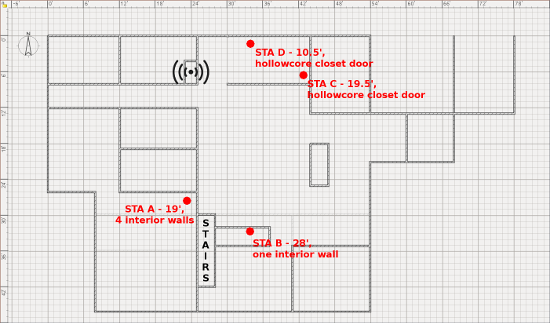
Read on SmallNetBuilder

The only place I could really ding the EAP-225's interface is in trying to identify the hardware version. This model has three hardware revs—v1, v2, and v3—and they have separate firmware lines. I eventually had to give up and go look at the physical label on the access point.
I do not believe that the extra MIMO stream really gave the A60 any advantage with my strictly 2x2 test stations.
Is the D-Link DAP-2610 really a v2? I can't find any references to any version other than the A1 covered in part 1 of the roundup. D-Link only lists hardware version A on their support page and there is only one FCC entry covering a DAP-2610.
What is the FCC ID printed on the label of your TP-Link EAP-225 v2, if any?
That's surprising to me since 4x4:4 devices typically outperform 3x3:3 devices in Tim's tests with a 2x2:2 STA.
I've removed references to v2 for the DAP-2610.You know what, I think you're right, and I brain-farted their actual description of it - which is DAP-2610 wave 2, referring to its MU-MIMO support.
No worries!You know what, I think you're right, and I brain-farted their actual description of it - which is DAP-2610 wave 2, referring to its MU-MIMO support.
I'd hate to tick you off again but it would be handy to have some more details about the internals of the V2. V1 is 2x2:2 for 2.4GHz bgn while V3 is actually 3x3:3 for 2.4GHz bgn. The product page for V2 suggests that it is 2x2:2 so I'm guessing that V2 is pretty much identical to V1 and may even share its FCC id.Dunno off the top of my head; but I think the FCC ID on the label is what I went by eventually. Couldn't figure it out from the UI or from the box - having to go chase down the physical access point itself and hunt for labels was what ticked me off. =)
My understanding is that additional tx/rx chains can help improve receive sensitivity and effective transmit power so a difference could be more evident at longer distances or in situations where there is more interference or reduced signal quality.In the real world, I've never seen any correlation between large number of MIMO streams on the AP and 2x2 STA performance. Granted, I've spent more time debunking that on consumer routers and mesh kits (which love to claim ridiculous "AC speed ratings" based on adding up all the MIMO streams multiplied by all the radios multiplied by some extra "just for fun" fudge factors). But nothing I've seen there, or any understanding I have of the technology, leads me to believe that it would be any different in these APs. And the OpenMesh A60 certainly did not seem to stand out here.
My understanding is that additional tx/rx chains can help improve receive sensitivity and effective transmit power so a difference could be more evident at longer distances or in situations where there is more interference or reduced signal quality.
I would like to know if using band steering whether you can maintain a FaceTime call. If not can you turn off the 2.4GHz radio then maintain a FaceTime call across APs. It seems like a simple test.
My wife uses FaceTime a lot while walking around the house and outside.
Just saying - I've spoken about this before...The stations themselves are four identical Samsung Chromebooks running GalliumOS equipped with a built-in Intel Dual Band Wireless-AC 7265 and Linksys WUSB-6300 external wireless adapters. The WUSB-6300 is my reference adapter and used for most performance testing, because there's less variation between the four NICs than there is between the internal NICs in the Chromebooks, and also because they have exceptional TX performance.[/code]
How would you test roaming without a STA to roam?@Jim Salter - you are testing the clients, not the AP's...
@Jim Salter - you are testing the clients, not the AP's...
Just saying - I've spoken about this before...
How would you test roaming without a STA to roam?
I'm working toward being able to catch deauth (AP-enforced minRSSI) and BSS transition frames in-flight, but I'm not there yet; in the meantime empirical testing is much better than no testing at all.
Hence my statement - the roaming tests were more about the client than the AP's - without a stable baseline, it's all subjective.
It happens even on controllers you build on PCs or servers, even virtualized cloud controllers. Granted..those rarely experience a rude shutdown.

Welcome To SNBForums
SNBForums is a community for anyone who wants to learn about or discuss the latest in wireless routers, network storage and the ins and outs of building and maintaining a small network.
If you'd like to post a question, simply register and have at it!
While you're at it, please check out SmallNetBuilder for product reviews and our famous Router Charts, Ranker and plenty more!
